Latest posts by (see all)
- The Best Things to Do in Tulsa - June 26, 2020
- The Most Interesting Things to Do in Springfield Mo - June 15, 2020
- Best Things to Do in Salt Lake City - May 26, 2020
- 10 Best Websites for Playing Online Games - May 22, 2020
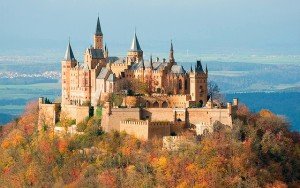 Germany is one of the most popular countries among tourists in Central Europe, an ideal place for year-round recreation. People come here to see the remnants of the Berlin Wall, which for almost half a century divided one people into two different states, the picturesque lakes of Bavaria, where you can swim in the summer, relax in the world famous resort of Baden-Baden. Germany is famous for its ancient cities, some of them still have traces of medieval buildings, festivals, and the best in Europe beer. Germany – the birthplace of many famous poets, writers and composers, and visitors have a great chance to get acquainted with their life and creativity going to the museum expositions.
Germany is one of the most popular countries among tourists in Central Europe, an ideal place for year-round recreation. People come here to see the remnants of the Berlin Wall, which for almost half a century divided one people into two different states, the picturesque lakes of Bavaria, where you can swim in the summer, relax in the world famous resort of Baden-Baden. Germany is famous for its ancient cities, some of them still have traces of medieval buildings, festivals, and the best in Europe beer. Germany – the birthplace of many famous poets, writers and composers, and visitors have a great chance to get acquainted with their life and creativity going to the museum expositions.
The main attraction of Germany is the famous German pedantry and order. What does this mean for the tourist? It is easy to navigate that, four stars on the facade of the hotel, a four-star level of service, that the train will depart from the station on a schedule, and a bun in a cafe will necessarily be fresh and tasty. In such conditions, it is easy to plan a trip, and it is pleasant to carry out plans, even if they are grandiose.
Contents
- Place to visit number 1: Reichstag Building
- Place to visit number 2: Zoo in Berlin
- Place to visit number 3: Brandenburg Gate
- Place to visit number 4: Palace Zwinger
- Place to visit number 5: Charlottenburg Palace
- Place to visit number 6: Cologne Cathedral
- Place to visit number 7: The Church of St. Nicholas
- Place to visit number 8: The Maxim Gorky Theater
- Place to visit number 9: The German opera
- Place to visit number 10: Kulmbach brewery
- Video
Place to visit number 1: Reichstag Building
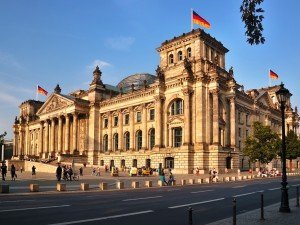 The Reichstag building, which is perhaps the most popular tourist attraction in Berlin, was built for the first parliament of the German Empire. In this building, which was opened in 1894, the Reichstag was held until 1933, when the building burned down during a fire, according to some reports, organized by the Dutch communist Marinus van der Lubbe, later executed. The National Socialists used this case as a pretext for purging the “traitors” in Berlin and banning the Communist Party of Germany, and subsequently usurpation of power. The building remained dilapidated until the 70s, when it was rebuilt and started to be used as a museum and sometimes as a building for meetings. In the 90’s, after the unification of Germany, it was reconstructed under the guidance of the world-famous architect Norman Foster. The work was completed in 1999, and now the German parliament – the Bundestag – is there.
The Reichstag building, which is perhaps the most popular tourist attraction in Berlin, was built for the first parliament of the German Empire. In this building, which was opened in 1894, the Reichstag was held until 1933, when the building burned down during a fire, according to some reports, organized by the Dutch communist Marinus van der Lubbe, later executed. The National Socialists used this case as a pretext for purging the “traitors” in Berlin and banning the Communist Party of Germany, and subsequently usurpation of power. The building remained dilapidated until the 70s, when it was rebuilt and started to be used as a museum and sometimes as a building for meetings. In the 90’s, after the unification of Germany, it was reconstructed under the guidance of the world-famous architect Norman Foster. The work was completed in 1999, and now the German parliament – the Bundestag – is there.
Despite the appearance of the German Empire in 1871, the Reichstag construction began only in 1884 and lasted for 10 years. Prior to this, the parliament met in other buildings on Leipziger Strasse. In 1882, an architectural competition took place, in which 189 architects took part. The winner was the architect Paul Vallo, who managed to realize his project. The first building of the
Reichstag was most famous for its original glass and steel dome, considered a technical masterpiece of the time.
Some historical facts about this attraction:
- During the 12 years of the reign of the National Socialists, no parliamentary meetings were held in the Reichstag building.
- During the Berlin operation in 1945, the Reichstag because of its symbolic significance became one of the main goals of the Red Army. Today you can see inscriptions of Soviet soldiers on the walls covered with fire, inside the building, as well as on the part of the roof preserved during the reconstruction.
- After the war, the building was almost completely destroyed. In addition, it was not used for its intended purpose because since 1949 the capital of West Germany was in Bonn.
- In 1961-1964 the Reichstag building was reconstructed according to the project of Paul Baumgarten.
Interesting: Until 1990, the building was used only for representative meetings and occasional events, such as, for example, a free concert of British rock band Barclay James’ Harvest, held on August 30, 1980. In its premises there was also a well-known permanent exhibition “Questions of German History”.
Back
Place to visit number 2: Zoo in Berlin
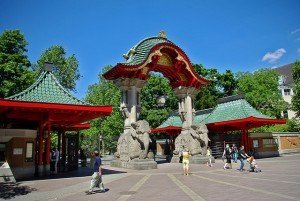 The oldest and certainly the most famous zoo in Germany is the place where you can see an unimaginable number of representatives of wildlife. No zoo in the world has so many species as there are in Berlin as there are about 1500 of them, and the total number of individuals reaches more than 17 000. Of course, with such diversity the zoo must be by no means small, therefore the territory of the Berlin zoo is impressive – in the vicinity 34 hectares. In 2011, about 3 million people became visitors of the zoo and a three-story aquarium. Some of the animals that lived here became world celebrities, for example, the dead, unfortunately, in 2011, the white cub Knut.
The oldest and certainly the most famous zoo in Germany is the place where you can see an unimaginable number of representatives of wildlife. No zoo in the world has so many species as there are in Berlin as there are about 1500 of them, and the total number of individuals reaches more than 17 000. Of course, with such diversity the zoo must be by no means small, therefore the territory of the Berlin zoo is impressive – in the vicinity 34 hectares. In 2011, about 3 million people became visitors of the zoo and a three-story aquarium. Some of the animals that lived here became world celebrities, for example, the dead, unfortunately, in 2011, the white cub Knut.
The Berlin Zoo opened on August 1, 1844 and became the first such institution in Germany and the ninth in the world. In the second half of the XIX century, several important enclosures were built, in particular, for:
- antelopes,
- elephants,
- ostriches,
- flamingos.
In 1913 an aquarium was built. The most sad page of history for the zoo was the Second World War, when the institution was almost completely destroyed, and out of 3,715 animals only 91 survived. In 1945-1956, when the director of the zoo was Katarina Heinrot, the place was rebuilt and a gradual increase in the number of zoo inhabitants began. Subsequently, the emphasis was also on breeding in captivity of rare and endangered species of animals.
Today the zoo is one of the most popular attractions. In recent years, popularity has increased due to the white bear Knut, who in 2007 became the first polar bear born in the Berlin Zoo for 30 years. His birth attracted the huge attention of the media, which could not but affect the flow of visitors. Knut became an international media figure, there were special toys, DVDs, books about the animal, and in Germany, a postage stamp bearing the image of a bear was issued.
Interesting: On March 19, 2011 Knut died in his aviary, before he reached the age of 5. The causes of death are not fully understood. Another famous animal of the zoo is the living giant panda Bao, born in 1978.
Back
Place to visit number 3: Brandenburg Gate
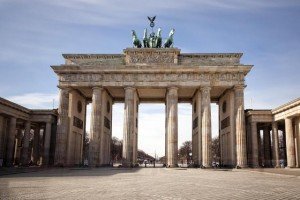 Perhaps the main symbol of Berlin – it’s the famous Brandenburg Gate, located at the end of the street Unter den Linden in front of the Tiergarten park.
Perhaps the main symbol of Berlin – it’s the famous Brandenburg Gate, located at the end of the street Unter den Linden in front of the Tiergarten park.
Some interesting facts:
- In the past, these were one of several gates through which one could get into the city, but at the end of the 18th century they were turned into a monumental triumphal arch.
- The construction of the Brandenburg Gate in 1788-1791 was led by Karl Gottgard Langgans, and the initiator of the erection was the Prussian King Frederick William II, son of Frederick the Great.
- Taking for a model of Propylaea on the Athenian Acropolis, Langgans created a neoclassical gate consisting of 12 impressive columns with five driveways, only the last of which was allowed to be used by commoners.
- The gates were decorated with the work of the sculptor Johann Gottfried Shadov.
It is interesting that the design of the gate did not change with time, although their history was patted. At first Napoleon moved the quadriga to Paris, but after his defeat the sculpture returned to Berlin. In 1871, Prussian troops returned through this gate after a brilliant victory over the French army, and in 1933 National Socialists celebrated their success there. The gate stood during the war, but was markedly destroyed. The restoration was completed in 1956, and the quadriga was re-established only a couple of years later.
Interesting: The gates located on the Paris Square after the erection of the Berlin Wall were in the eastern part of the city, and the wall was ugly as it was “bypassed”. Today, the gate again perfectly fits into the surrounding urban landscape.
Back
Place to visit number 4: Palace Zwinger
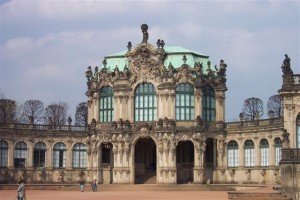 The most important attraction of Dresden is the palace Zwinger. This building of the architecture of the XVIII century is considered a highlight of the Saxon baroque and the legacy of the Saxon kings, also called electors.
The most important attraction of Dresden is the palace Zwinger. This building of the architecture of the XVIII century is considered a highlight of the Saxon baroque and the legacy of the Saxon kings, also called electors.
During the Second World War, there was no trace of Zwinger. However, the painstaking work of talented architects and archive drawings of the building completely recreated the original appearance of the palace. Zwinger consists of several buildings that are interconnected by transitions. Once in these buildings you could find:
- A mathematical cabinet,
- a huge library,
- a unique collection of engravings and porcelain,
- as well as a curio cabinet.
Today, the palace houses a number of important museums and the Dresden Picture Gallery. Among the museums of Zwinger, the most famous are:
- the Armory or the Museum of Armor and Cold Steel,
- the Museum of ancient clocks,
- the Museum of Meissen porcelain,
- the Museum of Mineralogy and Geology,
- and the Physics and Mathematics Museum.
Interesting: Festive performances were held in the courtyard, and the surrounding buildings served as a kind of theatrical box.
Back
Place to visit number 5: Charlottenburg Palace
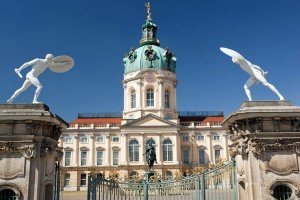 Charlottenburg is the largest palace in Berlin, built in the late 17th century in Baroque style was the residence of the royal dynasty of Hohenzollern. At that time it was outside Berlin, and today it is located in the same area of the German capital. Behind the palace there is a beautiful garden, and the palace itself is considered a model of baroque architecture in the country, which had the graceful elements of rococo.
Charlottenburg is the largest palace in Berlin, built in the late 17th century in Baroque style was the residence of the royal dynasty of Hohenzollern. At that time it was outside Berlin, and today it is located in the same area of the German capital. Behind the palace there is a beautiful garden, and the palace itself is considered a model of baroque architecture in the country, which had the graceful elements of rococo.
The construction of the palace was a whim of Sophia Charlotte, the wife of the Prussian King Frederick I, and at first the castle was called Lietzburg and was the summer residence of the royal family. Completed in 1699, two and a half-storey palace decorated with Corinthian pilasters, in the XVIII century significantly increased: two new wings were built at the sides, a beautiful tower with a dome and a greenhouse were designed by the architect Johann Friedrich von Eosander. Also on top of the tower there was a statue of Fortune, and the palace after the death of Charlotte in 1705 was renamed Charlottenburg. By the way, it was in this palace that the legendary Amber Room was located, which in 1716 was donated to Peter I and transported to St. Petersburg. Also at this time, a beautiful garden behind the palace appeared, the main attractions of which are:
- the belvedere,
- the mausoleum, where some members of the royal family are buried.
Today, a number of palace premises are open for visitors, as well as (for an additional fee) a mausoleum, a belvedere (where the Berlin porcelain museum is located) and a new pavilion with a collection of works of art from the time of the famous architect Carl Friedrich Schinkel, who built this pavilion.
Interesting: In the palace itself, in front of which there is a monument to Friedrich Wilhelm I, the beautiful Porcelain room and the apartments of Frederick the Great deserve special attention.
Back
Place to visit number 6: Cologne Cathedral
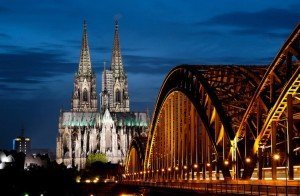 The Cathedral of Saints Peter and Mary in Cologne – this is a structure, the visit of which is not even specified by any guest of the city. It’s just a must-see. Indeed, located in the historic center of Cologne, the grandiose five-faceted basilica, which reaches 157 meters in the highest point, is very beautiful and arouses genuine admiration for the smoothness of the lines and the refinement of the outlines. The first stone in the foundation of the cathedral was laid in 1248, and then the construction for various reasons stretched for more than 6 centuries and officially ended only in 1880, although endless finishing and restoration work is periodically conducted inside the church to this day.
The Cathedral of Saints Peter and Mary in Cologne – this is a structure, the visit of which is not even specified by any guest of the city. It’s just a must-see. Indeed, located in the historic center of Cologne, the grandiose five-faceted basilica, which reaches 157 meters in the highest point, is very beautiful and arouses genuine admiration for the smoothness of the lines and the refinement of the outlines. The first stone in the foundation of the cathedral was laid in 1248, and then the construction for various reasons stretched for more than 6 centuries and officially ended only in 1880, although endless finishing and restoration work is periodically conducted inside the church to this day.
For the exterior decoration of the cathedral stone trachyte reddish shade was used. The size of the main building of the temple is 144 meters, the height to the crest of the roof is about 60 meters. To its western facade, there are two giant towers with pointed spiers, one and a half hundred meters in height. Outside the building there are many architectural support elements in the form of:
- pilasters,
- arkbutans,
- galleries,
- through gratings.
The main portal is exquisitely decorated with numerous small sculptures, stone carvings and pointed arches, located in several tiers and copying each other.
All the interior space of the building, lined with a gray Rhine stone, occupies a huge central hall, star-shaped arches of which rest on 44-meter columns. The perimeter of the hall is surrounded by a variety of chapels. Inside the giant towers there are spiral staircases of 509 steps each, ending at an altitude of about 100 meters by the belfry, serving both as a viewing and inspection. The view of Cologne from them is simply amazing. Cologne Cathedral enjoys incredible popularity among tourists visiting
Interesting: The cathedral is not only a cult temple for conducting religious rituals, but also a large museum of church relics and unique values.
Back
Place to visit number 7: The Church of St. Nicholas
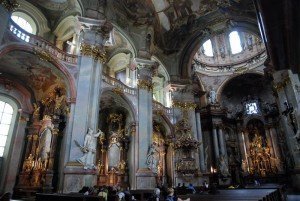 The Church of St. Nicholas once was one of the five Lutheran churches in Hamburg, and in the brief period from 1874 to 1876 – the highest building of the planet due to its 147-meter tower. However, today only the tower remained from the church, while the rest of the church was destroyed during the bombing of Hamburg during the Second World War. The tower serves as a city memorial, although the church is planning to rebuild.
The Church of St. Nicholas once was one of the five Lutheran churches in Hamburg, and in the brief period from 1874 to 1876 – the highest building of the planet due to its 147-meter tower. However, today only the tower remained from the church, while the rest of the church was destroyed during the bombing of Hamburg during the Second World War. The tower serves as a city memorial, although the church is planning to rebuild.
The building of the cathedral of St. Nicholas began in 1335, shortly before the appearance of plague in Europe. The cathedral was built in the style of northern Gothic. The towers of the church were consistently unsuccessful:
- one burned down in 1589,
- and the other collapsed in 1644.
On this, as usual, the troubles did not end, and the church was actually destroyed by the fire of 1842. After that, it was quickly rebuilt in the Neo-Gothic style, but the Second World War proved to be a merciless fire.
Interesting: Today from the once majestic building only 147-meter tower remained, which in 1990 and 2012 was reconstructed.
Back
Place to visit number 8: The Maxim Gorky Theater
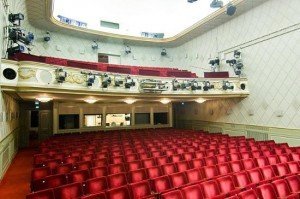 The Maxim Gorky Theater in the center of Berlin is the smallest state theater in the capital, with a capacity for 440 spectators. The theater is located in the choir of the Vocal Academy of Berlin near the street Unter den Linden. The theater has a second playground (Gorky Studio), located near the main building on Hinter dem Gießhaus. Named after the great Russian writer, the theater was founded in 1952 on the territory of East Berlin as a response to the epic The Brecht Theater. The opening took place on October 30, 1952, the first German production of the Soviet play “For those in the sea” by Boris Lavrenyov. Stanislavsky’s pupil Maxim Valentin was in charge of the production.
The Maxim Gorky Theater in the center of Berlin is the smallest state theater in the capital, with a capacity for 440 spectators. The theater is located in the choir of the Vocal Academy of Berlin near the street Unter den Linden. The theater has a second playground (Gorky Studio), located near the main building on Hinter dem Gießhaus. Named after the great Russian writer, the theater was founded in 1952 on the territory of East Berlin as a response to the epic The Brecht Theater. The opening took place on October 30, 1952, the first German production of the Soviet play “For those in the sea” by Boris Lavrenyov. Stanislavsky’s pupil Maxim Valentin was in charge of the production.
The building is one of the oldest concert halls in Berlin. It was built at the request of the Vocal Academy of Berlin, founded in 1791 by Karl Friedrich Christian Fash. They built their own corps for concerts and an educational building. The building is designed in the style of classicism.
The theater is a rectangular building with a facade reminiscent of the facade of the temple:
- The narrow side, which is visible, is divided into three parts by a large Corinthian pilaster and is framed by a girder with a tympanum.
- Portals are decorated like a chapel, above them the mirrors are separated by cornices.
Interesting: After the Second World War, the facade of a heavily damaged building was reconstructed according to original plans. The exception was only the side facades, which were open before the war, as windows were located on both floors.
Back
Place to visit number 9: The German opera
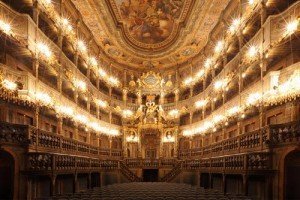 The German opera was founded in 1912, so do not confuse it with the German state opera, which foundation date dates back to 1742. Originally, the German Opera was the main opera house in the city of Charlottenburg, which in 1920 became part of Berlin.
The German opera was founded in 1912, so do not confuse it with the German state opera, which foundation date dates back to 1742. Originally, the German Opera was the main opera house in the city of Charlottenburg, which in 1920 became part of Berlin.
Why is it worth visiting this place?
- During the Second World War the old building of the opera was destroyed by bombing, and a new German opera was built only in 1961.
- It is worth adding that the Berlin State Opera was on the territory of the GDR. On the opening day, Mozart’s opera Don Giovanni was staged.
Interesting: After this, the opera regained its former glory, a number of very important prime ministers were held here, in particular, the “Oedipus” of Wolfgang Rome and some others.
Back
Place to visit number 10: Kulmbach brewery
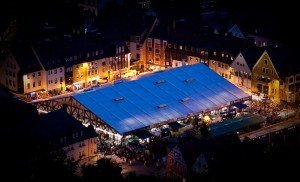 The museum was opened very recently – in 1994 – on the territory of more than 3000 sq.m. The museum is located in the old brewery Monchshof (“Monastic Yard”), which allowed to exhibit as historical exhibits just those that were used in its time in this old brewery, for example, a brewhouse and machine halls with all authentic equipment.
The museum was opened very recently – in 1994 – on the territory of more than 3000 sq.m. The museum is located in the old brewery Monchshof (“Monastic Yard”), which allowed to exhibit as historical exhibits just those that were used in its time in this old brewery, for example, a brewhouse and machine halls with all authentic equipment.
The 4-storey museum is located at the foot of the castle of Plassenburg, and its “beer garden” (Biergarten) and the Bakery Museum serve as “bonuses” to it, reminding visitors of the close connection of the two branches.
Also in the museum you will be able to enjoy:
- “beer seminars”, where guests can learn a lot about various kinds of beer,
- “beer cultural days off”,
- and “days at the monastic yard” with excursions to the fortress of Plassenburg,
- walks,
- food,
- and, of course , beer.
Here, each visitor can learn everything about the history of brewing art, its subtleties and wisdom. You will have a chance to be a brewer and taste your own beer.
Back